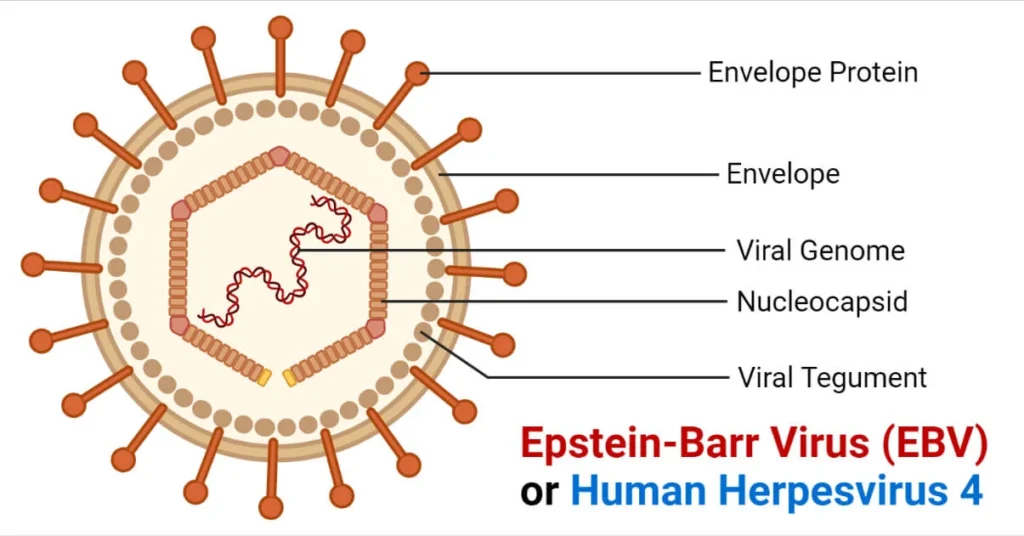Infectious mononucleosis, widely known as the “kissing disease,” is a viral infection most commonly caused by the Epstein-Barr virus (EBV). Although it primarily affects teenagers and young adults, individuals of all ages can contract this illness. The nickname “kissing disease” comes from the virus’s transmission through saliva, making kissing a significant mode of transmission. However, the virus can spread in various other ways as well.
Table of Contents
Causes and Transmission
The Epstein-Barr Virus (EBV)

The primary culprit behind infectious mononucleosis is the Epstein-Barr virus (EBV), a member of the herpesvirus family. This virus spreads through bodily fluids, especially saliva, which explains its association with kissing. However, kissing isn’t the only way to contract the virus. Here’s a closer look at how the virus is transmitted:
Common Modes of Transmission
- Kissing: Direct contact with an infected person’s saliva is the most well-known method of transmission, hence the term “kissing disease.”
- Sharing Utensils: Using the same cups, eating utensils, or toothbrushes as someone infected can lead to the spread of the virus.
- Blood and Semen: The virus can also be transmitted through sexual contact, blood transfusions, or organ transplants.
- Contaminated Surfaces: Touching surfaces or objects contaminated with the virus and then touching your mouth or nose can also spread the infection.
Symptoms of Infectious Mononucleosis
The symptoms of infectious mononucleosis can be wide-ranging, with some individuals experiencing mild symptoms while others face more severe issues. It’s important to note that symptoms may take four to six weeks to appear after exposure to the virus.
Common Symptoms
- Fatigue: A hallmark of the disease, extreme tiredness can persist for weeks or even months, significantly affecting daily life.
- Fever: Patients often experience elevated body temperatures, which can be persistent.
- Sore Throat: This can be severe, often resembling strep throat, but doesn’t respond to antibiotics since it’s viral.
- Swollen Lymph Nodes: Particularly in the neck and armpits, the lymph nodes can become noticeably enlarged.
- Swollen Tonsils: The tonsils may become enlarged and sometimes covered with white patches, adding to throat discomfort.
- Headache: Persistent headaches are common during the infection.
- Skin Rash: A rash may appear on the body, varying in severity from one person to another.
- Enlarged Spleen: The spleen may swell, causing discomfort in the upper left abdomen, a symptom that requires careful monitoring.
Diagnosing Infectious Mononucleosis
Diagnosing infectious mononucleosis can be challenging because its symptoms closely resemble those of other illnesses like strep throat or the flu. Healthcare providers rely on several methods to accurately diagnose the condition.
Diagnostic Methods
- Medical History and Physical Examination: A thorough review of the patient’s symptoms combined with a physical exam helps in the initial assessment.
- Blood Tests: Blood tests are essential to detect antibodies to EBV and to evaluate the number of blood cells, which can indicate infection.
- Complete Blood Count (CBC): A CBC helps rule out other infections or conditions that could be causing the symptoms.
Treatment and Management
Currently, there is no specific treatment for infectious mononucleosis. Since it’s a viral infection, antibiotics are not effective. Instead, treatment focuses on managing symptoms and ensuring a smooth recovery.
Managing the Symptoms
- Rest: Adequate rest is crucial, as the body needs time to fight off the virus. Patients are often advised to take it easy and avoid overexertion.
- Hydration: Drinking plenty of fluids helps prevent dehydration and supports the body’s recovery process.
- Pain Relief: Over-the-counter medications like acetaminophen or ibuprofen can help reduce fever and alleviate pain.
- Avoiding Physical Activity: Particularly, avoiding activities that could impact the spleen, such as contact sports, is important, as the spleen may be swollen and at risk of rupture.
Potential Complications
While most people recover from infectious mononucleosis without any major issues, there are potential complications, some of which can be serious.
Possible Complications
- Enlarged Spleen: In rare cases, the spleen can become so swollen that it ruptures, which is a medical emergency. Sharp pain in the left side of the upper abdomen is a sign that immediate medical attention is needed.
- Hepatitis: Inflammation of the liver may occur, sometimes leading to jaundice, which is characterized by yellowing of the skin and eyes.
- Anemia: A decrease in red blood cells can occur, leading to fatigue and weakness.
- Thrombocytopenia: A decrease in blood platelets, which are crucial for clotting, can lead to excessive bruising or bleeding.
Prevention Strategies
Preventing infectious mononucleosis largely involves reducing the risk of coming into contact with the virus. While it’s not always possible to avoid exposure, especially since many people carry the virus without showing symptoms, some precautions can help minimize the risk.
Steps to Prevent Transmission
- Avoid Kissing: Refrain from kissing someone who has the infection, especially during the acute phase of the illness.
- Do Not Share Personal Items: Avoid sharing utensils, food, drinks, or personal items like toothbrushes with someone who might be infected.
- Practice Good Hygiene: Regular hand washing and avoiding touching your face with unwashed hands can reduce the likelihood of contracting the virus from contaminated surfaces.
Interesting Facts About Infectious Mononucleosis
Beyond the basic facts about the kissing disease, here are some intriguing tidbits that shed more light on this viral infection:
Fun Facts
- Common Among Teens: Infectious mononucleosis is most frequently diagnosed in teenagers and young adults, particularly those aged 15 to 24.
- Not as Contagious as It Sounds: Despite its nickname, the kissing disease is not as easily spread as the common cold or flu.
- Persistent Fatigue: One of the most challenging aspects of the disease is the long-lasting fatigue, which can continue for weeks or even months after other symptoms have subsided.
- EBV and Cancer: The Epstein-Barr virus has been linked to certain types of cancer, including Hodgkin’s lymphoma and nasopharyngeal carcinoma, highlighting its potential for more severe health implications.
- Asymptomatic Carriers: Many people carry the Epstein-Barr virus without ever showing symptoms, making it difficult to track and prevent the spread of the virus.
Also Read: What is Sloth Fever Virus? The emerging threat is raising concern among health officials
Conclusion
Infectious mononucleosis, often referred to as the “kissing disease,” is a viral infection caused by the Epstein-Barr virus. While the illness can be uncomfortable and, in some cases, debilitating, most individuals recover fully with proper rest and care. Understanding the causes, symptoms, and preventive measures can help manage the illness more effectively and reduce the risk of spreading the virus to others. With awareness and appropriate management, those affected can navigate the challenges of this illness and return to their normal routines with minimal complications.




